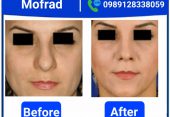nasal tip rotation and how to measure that
فهرست مقاله
- 1 nasal tip rotation and how to measure that
- 2 Nasal tip rotation
- 3 wide nose tip
- 4 Bulbous nose surgery is a special rhinoplasty procedure that involves reshaping a bulbous, round, or wide tip nose.
- 5 its to a more defined nose complimentary to ones face. The bulbosity of the nasal tip is typically due to excessive width to the cartilage, excessive “spring” to the cartilage making them bowed, or cartilages that are spaced to far apart or don’t have definition. Sometimes a bulbous tip can be due to thick nasal tip skin. This, in addition to the cartilage, is frequently seen in ethnic noses.
- 6 (Cause of droopy nose (nasal tip ptosis
- 7 How to Measure Nasal Tip Rotation
nasal tip rotation and how to measure that
Nasal tip rotation
If you have what some call a droopy nose where the tip of the nose naturally points downward or droops when you smile, you are candidate for a nasal tip rotation
The droopy nasal is also called nasal tip ptosis. Which can be present from birth or the result of a previous rhinoplasty . Nasal tip rotat refers to an upward tipping of the nose, increasing the angel between the upper lip and the bottom edge of the nose. Decreasing this angle would be constitute nasal tip derotation.
wide nose tip
Bulbous nose surgery is a special rhinoplasty procedure that involves reshaping a bulbous, round, or wide tip nose.
its to a more defined nose complimentary to ones face. The bulbosity of the nasal tip is typically due to excessive width to the cartilage, excessive “spring” to the cartilage making them bowed, or cartilages that are spaced to far apart or don’t have definition. Sometimes a bulbous tip can be due to thick nasal tip skin. This, in addition to the cartilage, is frequently seen in ethnic noses.
(Cause of droopy nose (nasal tip ptosis
- Elongated lower lateral or upper lateral cartilages
- Elongated nasal septum or nasal bridge
- Aging-related drooping due to gravity, weakened tip support and thinning nasal skin (like facial sagging)
- Previous nasal tip surgeries that weaken support for the nasal tip
- Shape and size of lower lateral cartilage; excess cartilage can cause a nose tip to droop
- Weak attachments between septum and upper lateral cartilage
- Accidental ptosis through traumatic deformation.
No matter the cause of the drooping nasal tip, consult with your surgeon to see if a nasal tip correction is the solution for you. If you are experiencing breathing problems due to a drooping nasal tip, ptosis correction through rhinoplasty may be a viable solution for helping you breathe easier once again.
How to Measure Nasal Tip Rotation
There are different desirable nasolabial angle ranges for men and women. The golden window for men is between 90 and 100 degrees, while a slightly more rotated tip is the preferred look for women between 95 and 108 degrees. A surgeon will always diagnose nasal tip ptosis by measuring the nasolabial angle before surgical correction, while a post-operation angle measurement verifies a successful nasal tip rotation
Dr amirhosein mohammadimofrad as an expert specialist will help you to achieve best result for nasal tiprotation.














